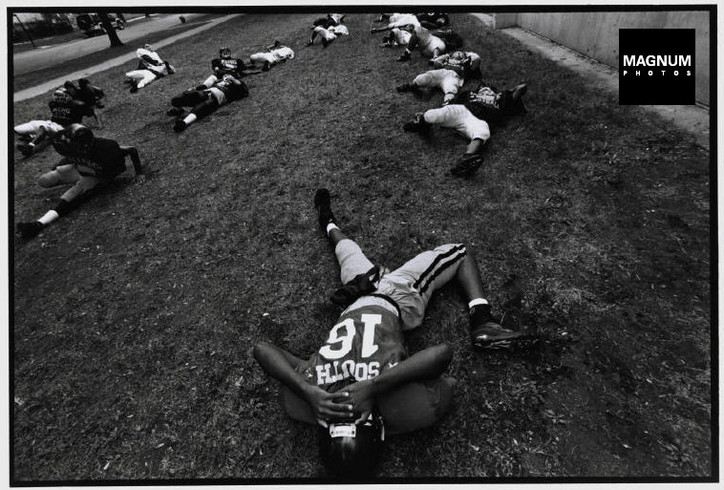Above Image: Martin Parr. USA. Abilene Christian University Wildcats at Oklahoma, join in pre-match prayer. 1995.
Stay informed on our latest news!


Above Image: Martin Parr. USA. Abilene Christian University Wildcats at Oklahoma, join in pre-match prayer. 1995.
To start, consider this koanic dialogue, adapted from the Japanese tradition: The student asks, "What wins championships?" The master responds, "A wide receiver that can fly will never die." The student asks, "Wide receivers win championships?" The master responds, "The special teams unit is appropriately named." The student asks, "The special teams unit is most important?" The master responds, "Coach Paul “Bear” Bryant said it best." The student asks, "Oh, defense is the key to victory?" The master responds, "The locks change every year." The student asks, "So every Super Bowl is different?" The master responds, "The pigskin was never made of pig."
Koan’s are meaningful only in that that they are meaningless. They are unsolvable riddles meant to frustrate your inner logician to the point of surrender. So, surrender then. Soften your focus, like a running back after a linebacker hits him with enough force to break down the average suburban front door. Release your grip, like a quarterback after a lineman karate chops his throwing arm so hard that the synapses force his hand open. Loosen your legs, like a tight end after a chop block renders him momentarily numb from the waist down. Or, in other words, relax.

Eli Reed, USA. Illinois. Chicago. 1998. Football practice at Martin Luther King High School on the side of the road. The football field is scheduled for completion in 2000.
Now that we’re working with an empty mind and an open heart, close your eyes. Imagine you are a player on the field, maybe a free safety. It’s 4th and goal, because of course it is. There’s a minute left in a tie game, because of course there is. Listen to your labored breathing, every inhale and exhale amplified within the confines of your helmet. While the opposing quarterback makes a few adjustments at the line of scrimmage, reflect on the fact that nearly every moment of your life was oriented by the remote possibility that this moment might come. And here it is. Welcome. You’ve arrived, and holy shit, you recognize the offense’s formation from the hundreds of hours you’ve spent in a dark room watching game tape. You know exactly what they are about to do.

Martin Parr. USA. On the sidelines before a football game at the University of Central Oklahoma. 1995.
The quarterback finishes audibling, settles behind the center, and suddenly, your vision blurs, and you are no longer just you, the free safety who is about to be the most celebrated athlete of the next 24-hour sports news cycle. You are also a fan in the nosebleed section who is noticing that the free safety—about the size of an ant from this distance—is sneaking toward the left side of the field as if he suspects that’s where the ball is about to be thrown. You’re not straddling these two perspectives. You have two feet firmly planted in both. That is, you are now simultaneously inside the game and outside of it. Participant and observer. Subject and object. Man and God.
It occurs to you that you might actually be Jesus Christ. But the quarterback has just called ‘HIKE,” so you set that possibility aside for now because you have work to do. You turn and sprint toward the back corner of the endzone. When you get there, you turn back around and look to the sky. There it is. It’s exactly where you thought it would be, exactly where it’s supposed to be, as if this game makes perfect sense, as if it was already written.

One might be able to identify newcomers by looking to see who has their fingers in their ears. On Sunday, the enclosed Prudential Center amplified and reverberated the machines’ leonine snarls, making it nearly unbearable to go without some sort of protective accessory. Those who didn’t have Monster Jam Triple Threat–sponsored earmuffs—fashioned to look like Tonka Truck wheels—had, instead, little bullets of orange foam riveted into the sides of their heads.
The high-octane junkies of the greater Essex county area had the privilege to witness such legends as El Toro Loco, Max-D, Blue Thunder, Grave Digger, Megalodon, Pirate’s Curse, Zombie, and Monster Mutt Rottweiler as their drivers competed in six contests to prove their speed, agility, and willingness to hurl themselves—and six tons of metal—through the air.
The rally began with a race. Two trucks were staged on opposite sides of the track, and when the light turned green, they mashed the throttle and skidded counter-clockwise to see who was able to complete three laps the fastest. Truck v. truck ripped and roared, spat and sputtered, and young boys’ and their fathers’ hollers were made inaudible by the Zeusonian cacophony. All in all, each race lasted no more than a minute; after three quick rounds on the rink, spike-studded Max-D (aka Maximum Destruction) took the win.


For the next round, the drivers left their massive tanks and hopped on relatively quiet ATVs for another, more dexterous race. Four competitors revved their engines at the starting line on one side of the arena; the track they navigated snaked across the raised dirt platform in the middle of the rink and around checkpoints placed on all four of its corners. Shark-themed Megalodon beat out crowd-favorite El Toro Loco in a suspenseful race after El Toro was disqualified for aggressive driving.
Next was the two-wheel skills challenge—the first of the three crowd-decided matches. The objective of this competition was simple: get the truck on two wheels in the most interesting way for the longest amount of time. Max-D, who landed a jump on its back two wheels and proceeded to pogo for a defying number of buoyant seconds, won the crowd’s approval.
More aggregated scores were given to the drivers during the next round for the speed, duration, and tightness of their donuts—if a truck whipped around especially quickly, their “donut” was elevated to the level of “cyclone.” Grave Digger, who is perhaps the most famous Monster Truck in the world, was the clear winner, maintaining a six-second cyclone that garnered a score of 9.


Breaking up the big truck races again, drivers mounted speedsters—or dune-buggies with an absurd amount of horsepower. The track made use of the full arena; drivers started the race by jumping the middle platform from opposing sides before merging into one lane that weaved around more checkpoints. Largely, the race was decided by whoever took the lead after the first jump. However, in a dramatic turn of events, Max-D, who was behind El Toro Loco the entirety of the final race, won after El Toro turned too tightly and spilled right before the finish line.
The final freestyle round was the most anticipated; it was a chance for a driver to showcase the fruits of years of labor behind the wheel. What’s the batshit-craziest thing they could make their truck do in 70 seconds? Reaching heights of 30 feet, six ton monsters leaped in the air like growling ballerinas; they delicately nosed onto their front wheels, waggling their ass in the air as they moonwalked across the arena. The daring (and most successful point-wise), used the sharp angle of the raised platform to send their massive machines straight towards the heavens, hanging for just one tantalizing moment before performing a full backflip and landing where they started. As the timer ticked down the final seconds of the very last round, Grave Digger managed to steal the air out of the crowd’s lungs with such a gravity-defying maneuver. However, much to the disappointment of The Black and Green Wrecking Machine’s devotees, it was Max-D, accumulating far more points than anyone else in the previous rounds, who won the day. And also a trip to Orlando.

And if you’re lacking motivation, but still want to be comfy and look good, feel free to cop some pieces for just hanging around the house. Don’t worry, we won’t tell Santa.











